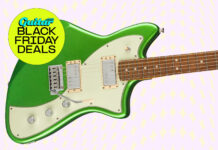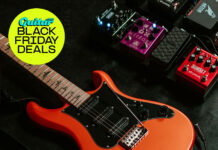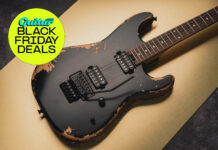
Vintage Bench Test: 1979 Gretsch White Falcon
If you think this guitar is flashy, it really has nothing on its case. When we first open it up, the most striking thing isn’t the Gretsch inside, but the furry dayglo-green lining. To upstage a White Falcon is no small achievement, but fear not – this is still a guitar that will get you noticed.
At 40 years of age, it’s indisputably a vintage instrument, but if it can be said that Gretsch had a ‘golden era’, this White Falcon was made some time afterwards. Yes, this is a Baldwin-era Gretsch and as such, it’s quite different from the guitars made in the original Brooklyn factory.
During the late Baldwin era, White Falcons were fitted with B12 Bigsbys and the pickguards acquired a more angular shapeFred Gretsch took the decision to sell his company to piano manufacturer Baldwin in 1967. By 1970, the new owners were in the process of shifting Gretsch production 1,000 miles away from Brooklyn to Booneville, Arkansas. Baldwin already had piano factories in the area and labour was cheaper, but few of the New York workforce – the folks familiar with the process of building Gretsch instruments – made the move.
Consequently, build quality suffered and even the company’s main endorser Chet Atkins declared: “They just couldn’t build Gretsch guitars at Booneville.” By the early 1980s, he had shifted his allegiance to Gibson. Baldwin Gretsches have always been somewhat stigmatised, although some Gretsch fans argue that it’s not entirely justified.
By the late 70s, Baldwin utilised metallised plastic control knobsSo what can we say about this Gretsch, which was made in the year before Baldwin decided to cease guitar production? Build quality is a tough thing to quantify and it might be helpful to approach it from two different angles – structural integrity/playability and standard of finish.
We have no concerns about this guitar’s solidity, because it’s built like a tank. Weighing in at over 10lbs, it’s heavier than many 1970s Les Paul Customs and the neck joint is as solid today as when it left the factory. Considering Booneville’s reputation for flimsy neck joints, that’s quite something. We’ll discuss the playability in detail later, but suffice to say, the neck is arrow straight, action is low and the guitar plays perfectly.
The back is padded for comfort and you’ll also need a padded strap for this 10-pounderWriting regularly about vintage equipment, we are able to distinguish between finish flaws and the inevitable wear and tear that goes with the territory. However, there can be no confusion here, because it’s clear this guitar has spent more time on display than on stage and since it’s in near-mint condition, no allowances are necessary.
This is Gretsch’s take on a tune-o-matic bridge, although here one screw has been inserted backwardsThe white lacquer has yellowed slightly and it was laid on very thickly – you can see and feel a distinct step where the white was scraped back, or masking tape was removed, to reveal the multi-ply black/white and gold-sparkle binding. These edges are far from crisp and the transition along the fingerboard binding is particularly sketchy. The paint is also fairly uneven and the gloss has subsided to a dull and slightly sticky surface.
The most bizarre aspect, however, is the filler around the neck joint. Whatever they used back in Booneville, it was slathered on in large quantities and appears to have been wiped smooth with someone’s finger rather than sanded.
They may be gold-plated, but the toggle switches are the type you’d find at any consumer electronics outletIt’s also clear that Baldwin was cutting costs and the chunky Switchcraft switches that Gretsch always used had by now been discarded for a pair of cheaper toggle units. Don’t be deceived by the gold plating – these are the type you can source from electronics outlets. What’s more, the lack of corrosion on the knobs can be attributed to the fact that they’re metallised plastic, while the head of the screw fixing the Bigsby to the top of the body is too large to fit into the countersink on this B12.
Chunky Grover tuners add weight to the headstock and zero frets were still preferred to regular nuts. Note the matching pick!The ebony bridge base has either warped over the years or no attempt was made to fit it to the top in the first place. On the plus side, the bridge appears to be pinned because it doesn’t move and the individual saddle adjustment means this Gretsch definitely plays in tune. The Grover tuners work really well too, and those big buttons tally with the White Falcon’s ostentatious image. Just try not to look too closely at the fingerboard inlays, because some are not square with the frets.
A cover plate conceals the access hole for the two-way Burns truss rodThe two-way truss-rod adjustment mechanism is another period curiosity. Prior to acquiring Gretsch, Baldwin bought Burns and the system fitted to this White Falcon is actually a Burns design. Adjustments are made by removing a cover plate adjacent to the heel and inserting a special tool to turn the 16:1 gear mechanism. Unfortunately, this tool isn’t supplied with the guitar, but the relief is perfect at the time of writing and we sense that this isn’t the type of neck that has a tendency to move.
In use
It’s hard to tell through the characteristically small Baldwin-era f-holes, but it appears that a series of wide notches was cut into maple brace stock, allowing it to bend and conform to the inner curve – exactly like kerfing on the rims of an acoustic guitar.
The Baldwin-era f-hole binding is much more haphazard than that of modern Gretsch instrumentsTwo of these kerf/braces are glued to the back and they’re both about an inch square. Glued between them, directly below the bridge, is a substantial block of mahogany and an inspection mirror reveals that there are two more of these braces on the top.
All this wood undoubtedly contributes to the weight and the fact that, acoustically at least, this White Falcon is nothing like our trestle-braced 6120. Despite being large and hollow, the White Falcon sounds and sustains much more like a loud solidbody and its slinky feel and slim-necked playability is more rock than rockabilly.
Much changed during the Baldwin era, but it’s generally accepted that Filter’Tron pickups remained consistent from the 50s through to the late 70sAny concerns about the finish quality quickly evaporates when you plug in because the ‘black top’ Filter’Trons sound just as good as 1960s units. They can growl, chime and bite – generally simultaneously – and one big advantage of the body’s rigidity is that it takes a lot of volume to make it feed back.
One of the few areas of wear can be seen on the Bigsby hinges, and it most likely occurred inside the caseThe switches feel as cheap as they look, and the tones offered by the ‘mud’ switch are predictably unappealing – but after a few squirts of DeoxIT in the pots, you’ll soon be channelling your inner Stephen Stills and Billy Duffy. Vintage White Falcons are rare, and rarer still in this condition, but this one could be yours for less than the cost of a nitro-finished reissue.
Key Features
PRICE £4,750 (inc. hard case)
DESCRIPTION Hollowbody guitar. Made in the USA
BUILD Laminated body with gold-sparkle binding, set neck, bound ebony fingerboard, pearl block markers and 21 frets
HARDWARE Grover tuners, Gretsch bridge with adjustable saddles, Bigsby B12 vibrato
ELECTRICS 2x Filter’Tron humbuckers
FINISH White nitrocellulose
SCALE LENGTH 647.7mm/24.5”
NECK WIDTH 43.3mm at nut, 53.0mm at 12th fret
DEPTH OF NECK 17.0mm at first fret, 21.0mm at 9th fret
STRING SPACING 34.1mm at nut, 50.6mm at bridge
WEIGHT 4.6kg/10.1lb
CONTACT ATB Guitars www.atbguitars.com
The post Vintage Bench Test: 1979 Gretsch White Falcon appeared first on Guitar.com | All Things Guitar.
Source: www.guitar-bass.net












